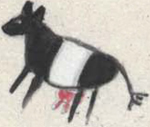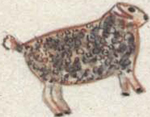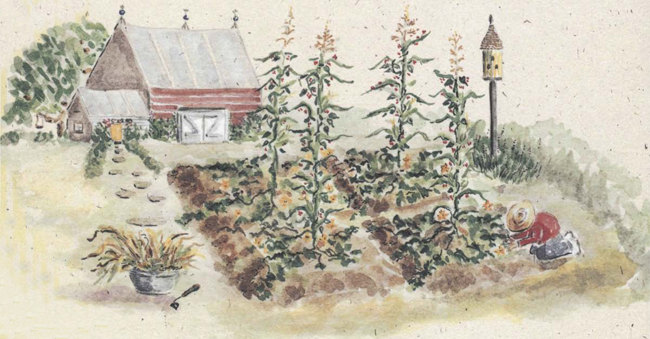
O’the fluttering and the pattering of the green things growing. How they talk each to each when none of us are knowing.
—Dinah Mulock Craike
Dig into the ancient traditions of Native American gardeners and harvest some of their best ideas for your own backyard. You’ll discover the water-saving wisdom and small-space ease of planting a Zuni-style latdekwi:we, or “waffle” garden, named because it looks like the breakfast treat. You can build your waffle block by block; start with the four-square version described in this chapter, or think big and create a giant.
Plant some of your blocks with the “Three Sisters of Life”—corn, beans, and squash—in the Iroquois way, using mounds. This important trio of crops help each other in several ways when interplanted. Corn planted deeply in a mound can withstand high winds, and mixed plantings of crops aren’t as likely to be destroyed by pests. Corn, the tallest member of the family, provides a support for her climbing sister, the bean. The bean takes nitrogen from the air and transfers it into the soil, enriching it for her two sisters. Squash spreads her big leaves over the ground, shading out sun-loving weeds and helping to conserve moisture for them all.

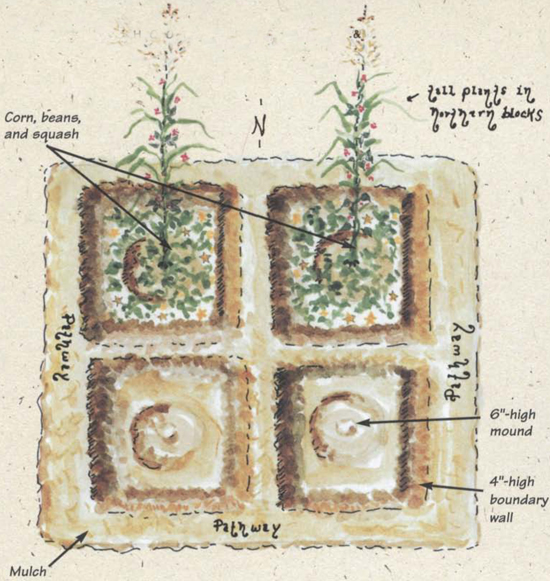
To create a four-block waffle, select a flat 12-by-12-foot area that gets at least six hours of sun daily. Outline a 7-by-7-foot square with a few handfuls of flour. Make sure one side of the square faces north. (Stand in the center of your plot at noon; the shadow you cast will point north.) Use flour to mark two more lines that divide the square into four equal blocks.
Hoe or shovel soil from the interior of each block, mounding it along the edges to form hard-packed, rounded, 4-inch-high boundary walls. Prepare the soil for planting (see Preparing the Soil). Add a few inches of aged manure to each block and work it into the soil. Mulch around the waffle to deter weed growth and conserve moisture.
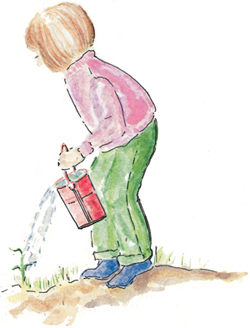
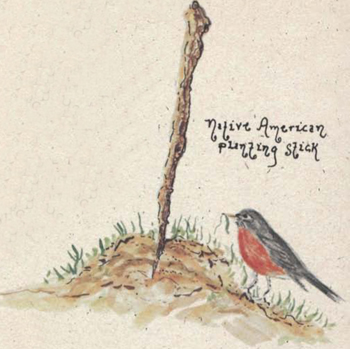
Begin planting this garden in late May. Plant the Three Sisters in the two blocks on the north side. This prevents the tall sister, corn, from casting too much shade on the smaller plants, such as the herbs and flowers you may have chosen for the remaining blocks. In the center of each block that you set aside for the Three Sisters, build up a soil hill that’s about 6 inches high and 18 inches across.
Corn is the first sister to be planted. Soak the kernels overnight to soften them. Use a Native American planting stick to poke 4-inch-deep holes about 4 inches apart in the mound. Drop a corn kernel into each hole, fill with soil, and pat down firmly. Water the, ground thoroughly.
When the corn is about 6 inches high, add another 2 inches of soil around the bases of the cornstalks. Water gently.
Near the base of each corn stalk, make a 1-inch-deep hole. Drop a runner bean into three of the holes and a squash seed in the fourth. Water again.
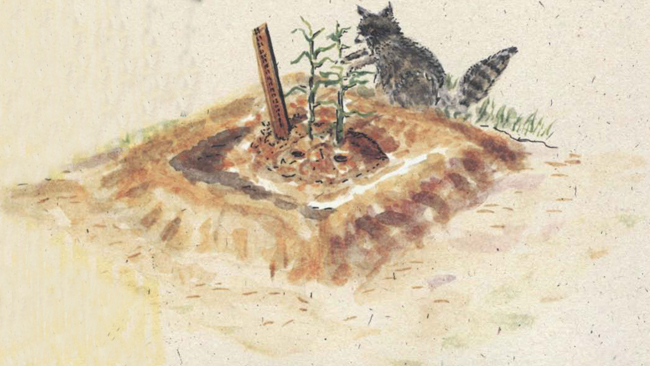
The first month of your Zuni Waffle Garden’s life is an important one for the germinating seeds and young plants. Check daily for moisture by poking your finger into the soil of each square. If the soil feels dry, fill the block to the brim with water.
Throughout the growing season, feed your plants every two weeks with a full-strength blend of liquid kelp and fish emulsion. Lend a helping hand to the runner beans by guiding their vines up the cornstalks. If the squash vines are crowding the corn, clip them at a node.
When the corn plants are about a foot high, mound more soil around their stalks to provide support; take care not to bury the young squash or bean plants while doing this.
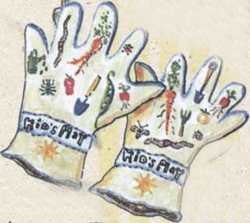
Many Native peoples knew the power of “singing the corn into the ground” as they planted. The Papagos walked their fields night after night and serenaded the growing corn, and the Hidatsas sang to their young plants as tenderly as a mother sings to her child. Here’s an old Papago song*:
The corn comes up.
It comes up green.
Here upon our fields.
White tassels unfolds
Blue evening falls.
Blue evening falls.
Nearby in every direction
It sets the corn tassels trembling.
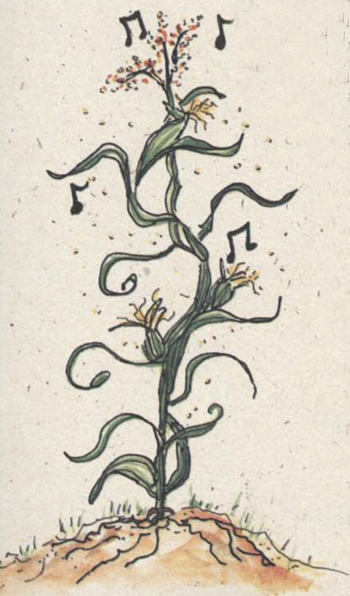

Take a walk with your “Sisters” and get to know them. Watch how they grow together and help each other through hot, windy days and long, buggy nights.
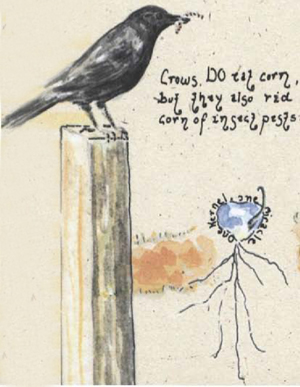
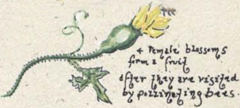
1. The male corn flowers are shaped like tassels and grow at the top of the plant. The lower-growing female flowers have silks and husks.
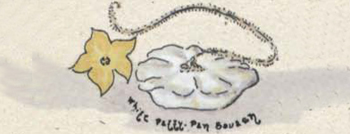
2. Examine the squash vines as they begin to flower. The blossoms with bulb-shaped fruit are the females that turn into squashes.
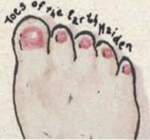
3. The roots of the cornstalk look like toes.
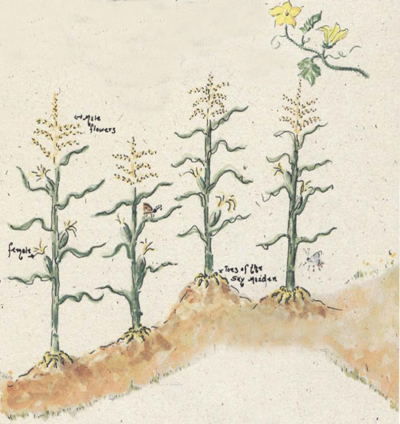
4. Gray hairstreak butterflies lay their eggs on corn leaves.
5. Here’s another “Three Sisters” garden of sunflowers, beans, and pumpkins. Scratch your name into the skin of a young, green pumpkin and watch it grow.

6. Snake your corn until the pollen from the male tassels reaches the female silks. Ears form from the pollinated silks.
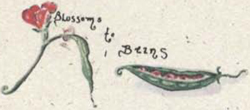
7. Nibble a few bean blossoms, but leave some to form pods of beans.
When the corn silks turn brown, the corn is mature. Pick and hang them in a dry area, or spread on newspapers to dry. Harvest the brown pods of the scarlet runner beans and dry them on screens. Gather the squashes, wipe clean, and store in a cool, dry place. They are beautiful displayed in baskets!
Try some of these activities with friends.
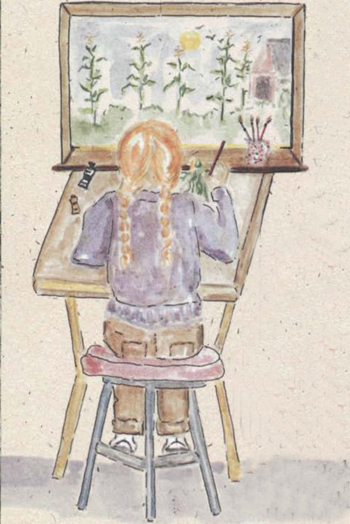

Cherokee legends of the origin of corn recount the time when a beautiful lady with silky golden hair, dressed in rustling green robes, came to earth and decided to stay. The maiden’s hair is the corn silk; her flowing robes are the leaves; her toes are the prop roots; her arms are the ears of corn waving farewell to her home in the sky. Paint a picture of the Corn Maiden the way you imagine her.

Break the scarlet runner bean pods apart, take out the beans, and play this Native American guessing game with a few friends. (You can also play it with dried corn kernels or squash seeds.)
Sit in a small circle, and have each player take a stockpile of thirty beans. All players but one close their eyes. That player counts out a few beans from his or her stockpile (no peeking!) and, cupping them in both hands, shakes them close to each player’s ear. Players guess the number and write it on a piece of paper.
Whoever guesses correctly gets the beans plus one bean from each player who guesses incorrectly. If more than one person is right, divide the beans among the winners. If no one guesses correctly, each player forfeits a bean. After everyone has taken a turn, count the beans; the one with the most is the winner.

You and your child can make necklaces or bracelets from jewel-toned Indian corn kernels. Pick hardened seeds out of dried corn-cobs. Soak the seeds in warm water for at least twelve hours. Use a thick, heavy-duty needle to pierce each softened kernel and string it onto heavy thread or dental floss. Tie a knot to form a circle.
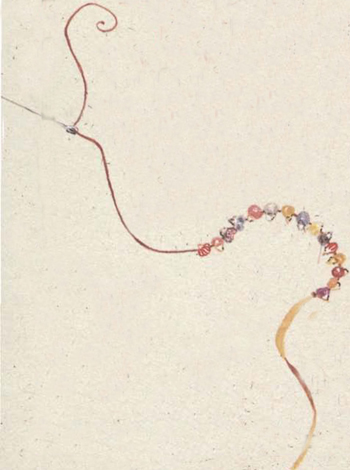

This craft is for kids aged nine and older, working with an adult. Cut a dry corn-stalk and trim it into pieces, cutting between the knobby nodes to make chunks of various lengths. The length of the piece determines the size of the animal. Use a knife to trim away parts of the stalk, then carve the trimmings into legs, necks, and tails.
These sections must have a sharp point that you can use to insert the piece into the body. Cut a small length of stalk to the size of your animal’s head, peel off the outer stalk, and carve the pithy core to shape. Decorate with acrylic paints.
